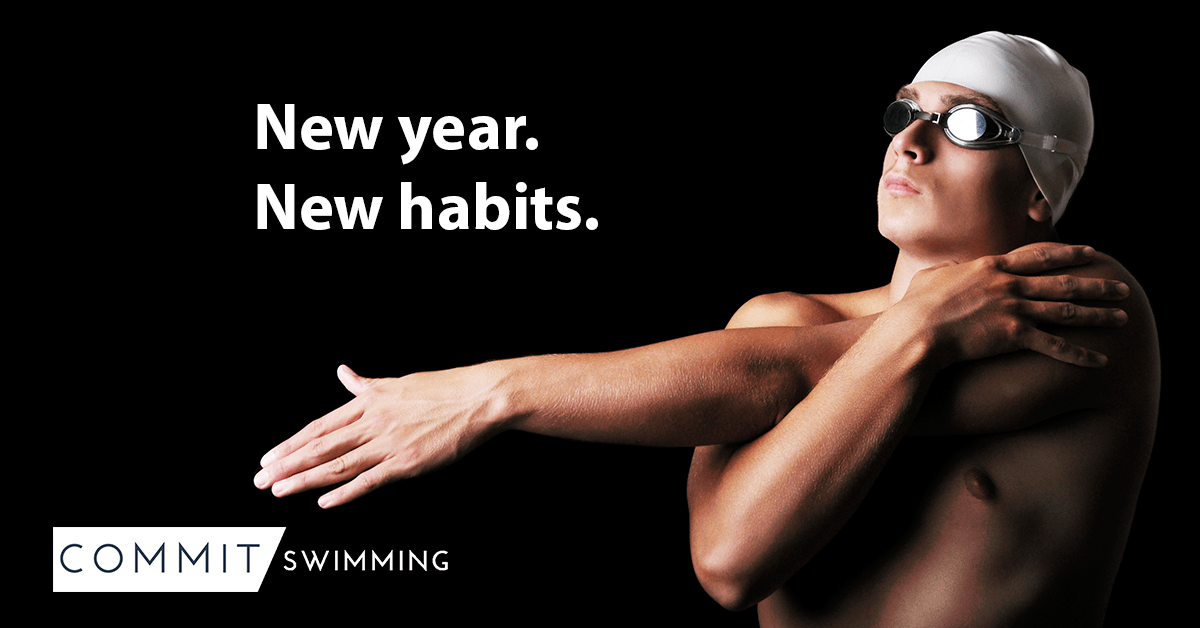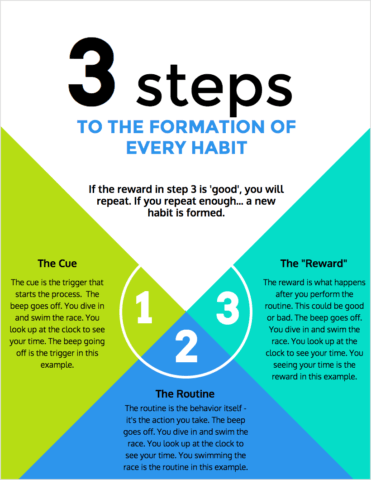Commit Swimming provides you (coaches and athletes) the platform you need to take your training to the next level. With Commit you can write, track, and analyze your workouts on any device. Commit is the #1 digital workout journal designed specifically for swimming, used by thousands of coaches and swimmers every day.
Coaches – Sign up for Commit’s 14 day FREE TRIAL (no credit card required)
Swimmers – Sign up for Commit’s FREE BETA.
This is part 2 of Commit’s 3 part series on the power of habit in swimming. If you missed part 1, click here to read it now! Not only do I explain why all this habit talk is so critical to your success in the sport of swimming, but I also talk about how habits are formed and why trying to form a new habit often fails.
Today I will explain tricks backed by the top behavioral psychologists’ research on how to form good habits. Stay tuned for part 3 over the next couple of weeks, where I will talk about how to maintain the good habits you form.
Part 1 – Why trying to form a good habit often fails
Part 2 – How to form good habits
Part 3 – How to maintain those good habits
REVIEW OF HABIT FORMATION
Reminder! Habits are everything in swimming. The result of every race you swim is the sum of your habits. Phew. Ok, now that that is out of the way, a quick review of habit formation…
Every habit is formed and maintained in this basic 3-step habit loop:
- The Cue – a trigger that prompts your habit behavior
- The Routine – the habit behavior itself
- The “Reward” – the result of doing the habit behavior. In quotes because this could be a good or bad result.
For more detail on this ‘habit cycle’, read part 1 of the series here.
6-STEPS TO SWIMMING HABIT OVERHAUL
In the 3-steps of habit formation, if the reward at the end is positive, you will want to (and actually will) repeat the routine again once you are ‘cued’. After doing this over and over, you have formed a habit! Alright, here’s your 6-step plan for how you use this habit formation process to your advantage in the pool…
1 – Start with a very very very small habit.
You have goals in swimming – I’m sure you have many goals. And it’s tempting to start there. But, goals are not habits. You hear stories of the coach who transformed an entire high school team into a State Championship team in 1 year, or the swimmer who, at 18 dropped 3 seconds off an already blazing fast 100 free. It’s easy to get caught up in this desire – the desire to get a ton faster right now. I get it. I’ve been there. The drive that you have is awesome. But you have to remember that true change is a product of daily habits, not crazy transformational improvements.
I hear swimmers say stuff like this all the time: “I need more motivation”. “I need more willpower”. I would respond: “No you don’t. You have plenty of motivation and willpower”
Willpower is like a muscle. It gets tired if you use it took much. If you want to start a new habit and begin chipping away at those times, then I have one suggestion that I cannot emphasis enough: start small. Pick a habit that is so simple it makes you laugh. Even if you have zero motivation at the time, you should not be able to say no to this first habit. How small am I talking? Say the habit you think you want to start is taking 5 dolphin kicks off of every wall at practice. Start with taking 1 kick – exactly 1 dolphin kick off of every wall. Not 2. Not 3. Just 1.
In the beginning, performance doesn’t matter. Whether you take 1 or 4 or 5 dolphin kicks just flat out does not matter. What matters is that you stick to the new habit. Become the type of swimmer who always sticks to your new habit. You can build up from 1 to 5 dolphin kicks once you’ve established a consistent behavior of taking 1 dolphin kick off of every wall. That part is easy. The hard part is actually building that initial behavior.
So to summarize: action step #1 is to pick what you want your new habit to be and figure out how you can make the new behavior so simple that you won’t need motivation to do it.
2 – Set up a reward for your new behavior
What do you get for taking that 1 dolphin kick of of every wall?
Remember that 3-step habit formation cycle? We all want to repeat things that make us feel good. So, you must reward yourself after you complete the routine in order for the routine to become habit.
How about this? After every turn, when you take that dolphin kick just stop and stand on the bottom of the pool. Skip a lap. That will feel good…. Just kidding! Don’t do that or your coach will get mad. But seriously, the reward doesn’t have to be big. It just has to exist. One thing I’ve tried and it worked for me, is simply screaming underwater “YES!”. Your teammates may think you’re nuts, but you can just tell them Commit Swimming told you to do it and to go read this article. Trust me. This stuff works. The world’s top athletes, business leaders, and entrepreneurs use this trick all the time.
Give yourself some credit (in whatever creative form you come up with) and enjoy each small step towards success.
3 – Set up a cue for your new behavior
I already talked about how motivation and willpower will fail you. Not only that, but memory will fail you too. You are human. I am human. And, we have imperfect memories. It’s as simple as that. That is why it’s so important to set a cue while forming new habits in your swimming life.
Let’s move away for the dolphin kicking example for a second, because the cue there is a physical one and not easy to change – pushing off the wall. For a moment, let’s pretend you want to get in the habit of stretching every day. Of course you’re following step 1 (start small) and only doing one stretch, say a hamstring stretch for 20 seconds. And you have already decided that after you do that stretch, you throw your arms into the air and yell ‘YES!’.
But, how do you ‘cue’ yourself to do this hamstring stretch? You can’t expect yourself to flip the switch one day and start stretching your hamstrings every day. First, you must set up a system that makes it easy for you to start doing this behavior.
I’ve heard this trick from a few people and use it myself: Make 2 lists. In the first list write down things that you do every single day without exception. In the second list write down things that happen to you each day without exception. Something like this…
List 1:
- Tie your shoes
- Get into bed
- Brush your teeth
- Step outside
- etc.
List 2:
- You get an email
- You get a text
- Your dog barks
- etc.
Between these two lists you have a number of triggers that you know will happen every day. What could possibly be better candidates for your ‘cue’?
Getting back to our example, to get started stretching every day, you brush your teeth which triggers you to do your hamstring stretch, and then scream ‘YES’!. Brushing your teeth could be your trigger to stretch. Do this routine for a month and you’ll be well on your way to forming a habit of stretching every day that is just as powerful as your teeth brushing habit.
4 – Take small steps to increase your habit.
For those of you finance gurus out there, you know the power of compounding interest. Habits are no different. Small percentage gains day in and day out add up freakishly fast. (As do small percentage declines.)
As you ramp up your habit, take small steps, not large ones. Just like you shouldn’t jump in with a habit that is too big to handle, you also shouldn’t take large steps with your habit. Gradual improvement is the winning formula in swimming.
5 – It’s okay to slip. But… When you do, get up quickly.
Even the best of the best in every sport make mistakes. They slip up and derail from time to time. But, what makes them special is their ability to get back on track faster than anyone else. Human error is in our nature, it’s what you do after the mistake that matters.
So bottom line is, it’s okay to miss your habit once. In fact, research has shown that missing your habit once has no measurable impact on your long-term success. As long as you don’t start missing that 1 dolphin kick consecutively each and every turn, and get back on track after 1 miss, you’re okay. That being said, failure shouldn’t be your expectation or it will happen too often. Expect to succeed, and when you fail, make sure it doesn’t happen consecutively.
6 – Be patient.
There is a quote that goes something like this… “You can’t rush something you want to last forever”. It’s generally used in the context of love. But, it applies to us in swimming too. You can make tremendous progress if you are consistent, persistent, and patient.
It’s not about how fast you can increase your habit to the point of reaching a larger goal. It’s about doing things that are actually sustainable. Back to our dolphin kick example… If you think you’re ready to increase the 1 kick to 2 kicks, it’s probably too early. Wait another couple days before you make that leap. Patience is everything. Eagerness is the #1 habit killer out there. Do things you can sustain.
If the habit is hard, you’re not doing it right. New habits should feel easy every step of the way. You should not feel resistance or the need for motivation to complete your habit. Stay consistent and move slowly. It’s a process. Trust it.
NEW YEAR. NEW HABITS.
At Commit Swimming, we want logging your workouts with Commit to be the 1 simple habit you form in 2017.
Athletes – Learn why logging is so important and then go sign up for Commit.
Coaches – Write your workouts with Commit. Don’t be this guy…
WHO IS COMMIT SWIMMING?
Commit’s team consists of 2 slow swimmers (Dan Dingman and Nico Gimenez) and 1 very slow swimmer (Dan Crescimanno). The team is passionate about the sport and is building innovative applications for both coaches and swimmers.
Contact them anytime at [email protected] with questions, feedback, or just to say hi. You can also follow them on Facebook, Twitter, or subscribe to their newsletter.
Swimming feature is courtesy of Commit Swimming, a SwimSwam partner.





